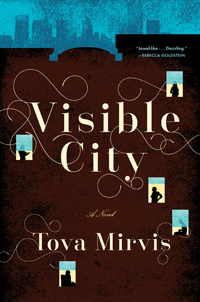Vista to Somewhere Else
In Tova Mirvis’s Visible City, entangled neighbors catch startling glimpses into each other’s lives
The characters of Tova Mirvis’s novel Visible City dwell in the glittering flux of New York, constantly exposed to moments of potential clash and change. They play their roles—stay-at-home mother, lawyer, therapist, art historian—as seamlessly as they can manage. But inside, they seek routes of escape, sending them down private tunnels of exploration or hurtling them toward one another in surprising encounters.
 Nina has taken to spying on her neighbors. Trapped inside her apartment with two sleep-challenged toddlers, her absent husband working, she is increasingly drawn to the life of another household through the windows across the street. But one day Nina’s picture of that household—the quiet, harmonious life of a middle-aged couple—is disrupted by the appearance of a passionate young woman. Soon, as if they were summoned through the sheer power of her curiosity, Nina begins to encounter these anonymous neighbors in real life.
Nina has taken to spying on her neighbors. Trapped inside her apartment with two sleep-challenged toddlers, her absent husband working, she is increasingly drawn to the life of another household through the windows across the street. But one day Nina’s picture of that household—the quiet, harmonious life of a middle-aged couple—is disrupted by the appearance of a passionate young woman. Soon, as if they were summoned through the sheer power of her curiosity, Nina begins to encounter these anonymous neighbors in real life.
The city itself lies at the center of the novel, providing not only its backdrop but also its animating heart. Hovering over numerous characters is the question New Yorkers face: should I stay, or should I go? Maneuvering her small children through the crush of city streets, Nina considers the prospect of quieter isolation in the suburbs but prefers “the city’s spectacle of people, the press of noise and light.” Meanwhile, her overworked husband, Jeremy, sleeps through his subway stop and wakes in the loud dark tunnel at the end of the line, snatching a glimpse into a sealed-off ghost station that he didn’t know existed. Jeremy’s imagination begins to stir, and he is dimly aware that, “as the subway hurtled forward, a passageway had opened inside him, a vista to somewhere else.” Visible City thrives on the allure of the hidden.
As the novel moves from one character’s point of view to another, empathy becomes its narrative fuel. We slip beyond any one character’s judgments, resentments, or fears. The antagonist of one chapter may well become the hero of the next. Nina’s dynamic with the other mothers in her neighborhood forms a starting point from which the novel unfolds:
 The only language spoken was certainty. Outwardly, she was reciting the maxims along with everyone else: The kids were always delicious and she wouldn’t miss this for the world, and there was nowhere else she’d rather be, and yes, it did go so fast. On the faces of other mothers, Nina sometimes caught the rumblings of discontent, but their inner lives were tucked away. Like theirs, her hands were always occupied, but while she was making dinner or bathing a child, while pushing one of them in a swing, rocking the other to sleep, her thoughts had begun to rove.
The only language spoken was certainty. Outwardly, she was reciting the maxims along with everyone else: The kids were always delicious and she wouldn’t miss this for the world, and there was nowhere else she’d rather be, and yes, it did go so fast. On the faces of other mothers, Nina sometimes caught the rumblings of discontent, but their inner lives were tucked away. Like theirs, her hands were always occupied, but while she was making dinner or bathing a child, while pushing one of them in a swing, rocking the other to sleep, her thoughts had begun to rove.
By carefully laying out the stakes—and the consequences—for each of her characters’ decisions, Mirvis brings a sense of newness to what otherwise might be familiar terrain. The novel gains steam as Nina begins to recognize the complex reality of her neighbors’ lives. The middle-aged couple—a therapist named Leon and an art historian named Claudia—is emotionally disconnected, merely co-existing in the same apartment. This seemingly untroubled arrangement becomes threatened by the arrival of their grown daughter, whose broken ankle hints at other fractures within the household.
Leon and Claudia’s careers throw into relief the youthful striving of Nina and Jeremy, who want to believe their unending work and sacrifice will yield reward. At midlife, however, Leon and Claudia have begun to reckon with the cumulative result of their professions: Claudia’s solitary work, studying the famed stained-glass artist John La Farge, hasn’t yielded wide respect among her colleagues, and Leon has begun to suspect that decades of professional deflection may have sealed him away from his own wife and daughter.
Once these characters’ entangled relationships and internal conflicts have been established, the novel hits a smooth stride of insight and surprise, as well as a fairly tight plot concerning a fight over neighborhood property developments and the possibility of an undiscovered La Farge masterwork. With all these elements in play, Visible City attempts to move beyond simple lessons of empathy to confront tougher questions about our inner lives. What is the price of self-knowledge? As we awaken to our lives’ true paths and illuminate our own secret caverns, do we inevitably disappoint or even betray those closest to us? Is it possible to bring them along, or must we always part company?
The finest accomplishment of Visible City lies in the fact that, though its tone remains hopeful, the novel offers no clear-cut answers or suggestion of finality. Mirvis’s graceful language, surprising turns of understanding, and gentle brushstrokes of fantasy make it tempting to believe that her characters live on past the novel’s luminous final chapter. They seem to be glancing back and forth forever, between street-level, at the faces of those they love, and skyward, into the glimmering lights of their bright city.
Tova Mirvis will discuss Visible City at The Booksellers at Laurelwood in Memphis on April 2, 2014, at 6 p.m.


